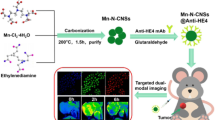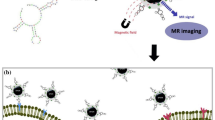Abstract
In this paper, we report a method for recognizing human ovarian tumor(HOT) cells using fluorescent biological label based on core-shell nanoparticles. The luminescent nanoparticles were synthesized with a water-in-oil(W/O)micromulsion technique. The fluorescent silica core-shell nanoparticles modified with anti-HER2 antibody using bifunctional cross-linker glutaraldedhyde targeted the corresponding tumor antigen in the cell surface of the SKOV3 ovarian cancer cells. The specific immunoreactivity of antibody-nanoparticles with cells was characterized by laser scanning microscopy (LSM) and scanning electron microscope (SEM). The results showed that the method offered potential advantages of sensitivity and simplicity due to high binding efficiency between nanoparticles and cells and provided an alternative method for the detection of HOT.





Similar content being viewed by others
References
Yang PH, Sun XS, Chiu JF, Sun HZ, He QY (2005) Transferrin-mediated Gold nanoparticle cellular uptake. Bioconjug Chem 16:494–496. doi:10.1021/bc049775d
Hoshino A, Fujioka K, Oku T, Suga M, Sasaki YF, Ohta T, Yasuhara M, Suzuki K, Yamamoto K (2004) Physicochemical properties and cellular toxicity of nanocrystal quantum dots depend on their surface modification. Nano Lett 4:2163–2169. doi:10.1021/nl048715d
Ye ZQ, Tan MQ, Wang GL, Yuan JL (2004) Preparation, characterization, and time-resolved fluorometric application of silica-coated terbium(III) fluorescent nanoparticles. Anal Chem 76:513–518. doi:10.1021/ac030177m
Zhou XC, Zhou JZ (2004) Mproving the signal sensitivity and photostability of DNA hybridizations on microarrays by using dye-doped core-shell silica nanoparticles. Anal Chem 76:5302–5312. doi:10.1021/ac049472c
Nakamura M, Shono M, Ishimura K (2007) Synthesis, characterization, and biological applications of multifluorescent silica nanoparticles. Anal Chem 79:6507–6514. doi:10.1021/ac070394d
He XX, Wang KM, Tan WH, Li J, Yang XH, Huang SS, Xiao D (2002) Photostable luminescent nanoparticles as biological label for cell recognition of system lupus erythematosus patients. J Nanosci Nanotech 2:317–320
Shangguan DH, Li Y, Tang ZW, Cao ZC, Chen HW, Mallikaratchy P, Sefah K, Yang CJ, Tan WH (2006) Aptamers evolved from live cells as effective molecular probes for cancer study. Proc Natl Acad Sci USA 103:11838–11843. doi:10.1073/pnas.0602615103
Ow H, Larson DR, Srivastava M, Baird BA, Webb WW, Wiesner U (2005) Bright and stable core—shell fluorescent silica nanoparticles. Nano Lett 5:113–117. doi:10.1021/nl0482478
Shukla R, Thomas TP, Peters JL, Desai AM, Kukowska-Latallo J, Patri AK, Kotlyar A, Baker JR (2006) HER2 specific tumor targeting with dendrimer conjugated anti-HER2 mAb. Bioconjug Chem 17:1109–1115. doi:10.1021/bc050348p
Verri E, Guglielmini P, Puntoni M (2005) HER2/neu on coprotein overexpression in epithelial overian cancer: evaluation of its prevalence and prognostic significance. Clinical study. Oncology 68:154–161. doi:10.1159/000086958
Gao Y, Wu Q, Ling X, Cheng L, Liu J (2007) Effect of anti-HER-2 engineered antibody chA21 on MMP-2 and TIMP-2 expression of human ovarian cancer SKOV3 cells. J Si’An Jiaotong Univ (Medical Sci) 28(4):368–371, 383
Liu YS, Sun YH, Vernier PT, Liang CH, Chong SYC, Gundersen MA (2007) pH-Sensitive photoluminescence of CdSe/ZnSe/ZnS quantum dots in human ovarian cancer cells. PhysChemComm 111:2872–2878
Hapca A, Nobs L, Buchegger F, Gurny R, Delie F (2007) Differential tumor cell targeting of anti-HER2 (Herceptin®) and anti-CD20 (Mabthera®) coupled nanoparticles. Int J Pharm 331:190–196. doi:10.1016/j.ijpharm.2006.12.002
Liu JM, Lu QM, Wang Y, Xu SS, Lin XM, Li LD, Lin SQ (2005) Solid-substrate room-temperature phosphorescence immunoassay based on an antibody labeled with nanoparticles containing dibromofluorescein luminescent molecules and analytical application. J Immunol Methods 307:34–40. doi:10.1016/j.jim.2005.09.007
Ao LM, Gao F, Pan BF, He R, Cui DX (2006) Fluoroimmunoassay for antigen based on fluorescence quenching signal of gold nanoparticles. Anal Chem 78:1104–1106. doi:10.1021/ac051323m
Nichkova M, Feng J, Sanchez-Baeza F, Marco MP, Hammock BD, Kennedy IM (2003) Competitive quenching fluorescence immunoassay for chlorophenols based on laser-induced fluorescence detection in microdroplets. Anal Chem 75:83–90. doi:10.1021/ac025933n
Brewer M, Utzinger U, Silva E, Gershenson D, Bast RC, Follen M, Richards-Kortum R (2001) Fluorescence spectroscopy for in vivo characterization of ovarian tissue. Lasers Surg Med 29:128–135. doi:10.1002/lsm.1098
Santra S, Zhang P, Wang KM, Tapec R, Tan WH (2005) Conjugation of biomolecules with luminophore-doped silica nanoparticles for photostable biomarkers. Anal Chem 73:4988–4993. doi:10.1021/ac010406+
Wang L, Yang CY, Tan WH (2005) Dual-luminophore-doped silica nanoparticles for multiplexed signaling. Nano Lett 5:37–43. doi:10.1021/nl048417g
Wang L, Tan WH (2006) Multicolor FRET silica nanoparticles by single wavelength Excitation. Nano Lett 6:84–88. doi:10.1021/nl052105b
Bagwe RP, Yang C, Hilliard LR, Tan WH (2004) Optimization of dye-doped silica nanoparticles prepared using a reverse microemulsion method. Langmuir 20:8336–8342. doi:10.1021/la049137j
Yang W, Zhang CG, Qu HY, Yang HH, Xu JG (2004) Novel fluorescent silica nanoparticle probe for ultrasensitive immunoassays. Anal Chim Acta 503:163–169. doi:10.1016/j.aca.2003.10.045
Ye ZQ, Tan MQ, Wang GL, Yuan JL (2005) Development of functionalized terbium fluorescent nanoparticles for antibody labeling and time-resolved fluoroimmunoassay application. Talanta 65:206–210
Zhang ZR, Zhong LF (2004) Cultural cytology and technique for cell culture. Scientific Technology, Shanghai, pp 47–51
Yuan Y, He XX, Wang KM, Tan WH, Peng JF, Huang SS, Lin X (2005) New method for preparing core—shell fluorescent nanoparticles doped with rhodamine B isothiocyanate. Chem J Chin Uni 3:446–448
Jaturanpinyo M, Harada A, Yuan XF, Kataoka K (2004) Preparation of bionanoreactor based on core-shell structured polyion complex micelles entrapping trypsin in the core cross-linked with glutaraldehyde. Bioconjug Chem 15:344–348. doi:10.1021/bc034149m
Chung LA (1997) A fluorescamine assay for membrane protein and peptide samples with non-amino-containing lipids. Anal Biochem 48:195–201. doi:10.1006/abio.1997.2137
Nakata H, Ohtsuki T, Abe R, Hohsaka T, Sisido M (2006) Binding efficiency of elongation factor Tu to tRNAs charged with nonnatural fluorescent amino acids. Anal Biochem 348:321–323. doi:10.1016/j.ab.2005.08.008
Mosmann T (1983) Rapid colorimetric assay for cellular growth and survival: application to proliferation and cytotoxicity assays. J Immunol Methods 56:55–63. doi:10.1016/0022-1759(83)90303-4
Harlow E, Lane D (2002) Using antibodies: a laboratory manual. Science, Beijing, pp 18–21
Acknowledgments
This work was supported by the National High-tech R&D program (863 program, 2007AA06Z402), Project of the Foundation of Shanghai Municipal Government (08520510400), Shanghai Leading Academic Discipline Project (S30406) and Leading Academic Discipline Project of Shanghai Normal University(DZL706).
Author information
Authors and Affiliations
Corresponding author
Rights and permissions
About this article
Cite this article
Huang, S., Li, R., Qu, Y. et al. Fluorescent Biological Label for Recognizing Human Ovarian Tumor Cells Based on Fluorescent Nanoparticles. J Fluoresc 19, 1095–1101 (2009). https://doi.org/10.1007/s10895-009-0509-4
Received:
Accepted:
Published:
Issue Date:
DOI: https://doi.org/10.1007/s10895-009-0509-4




